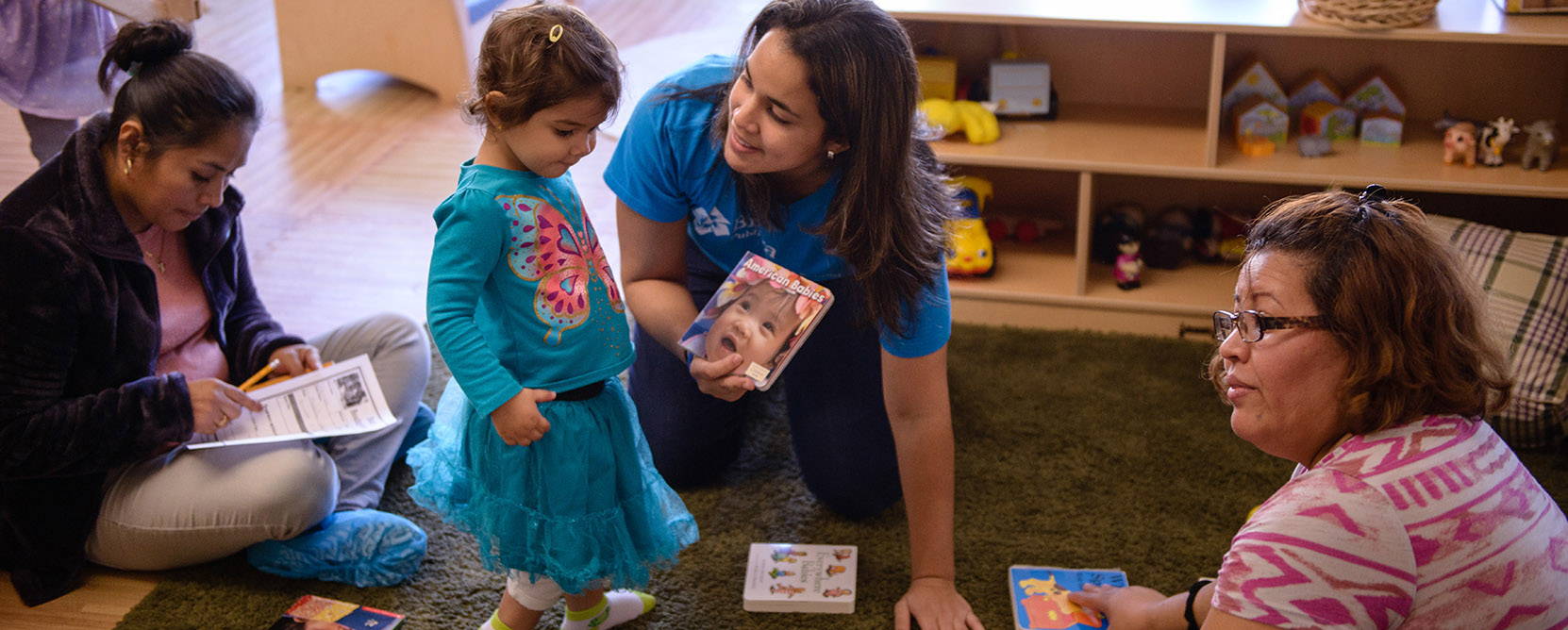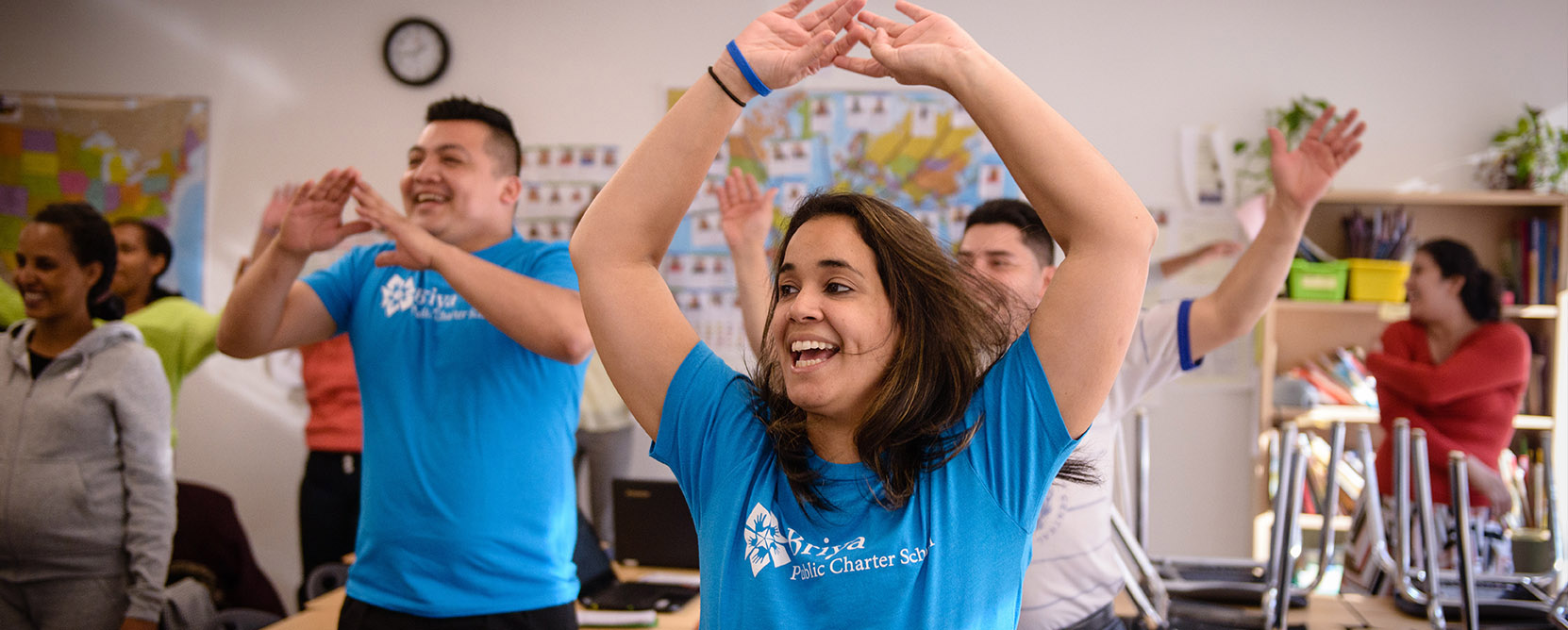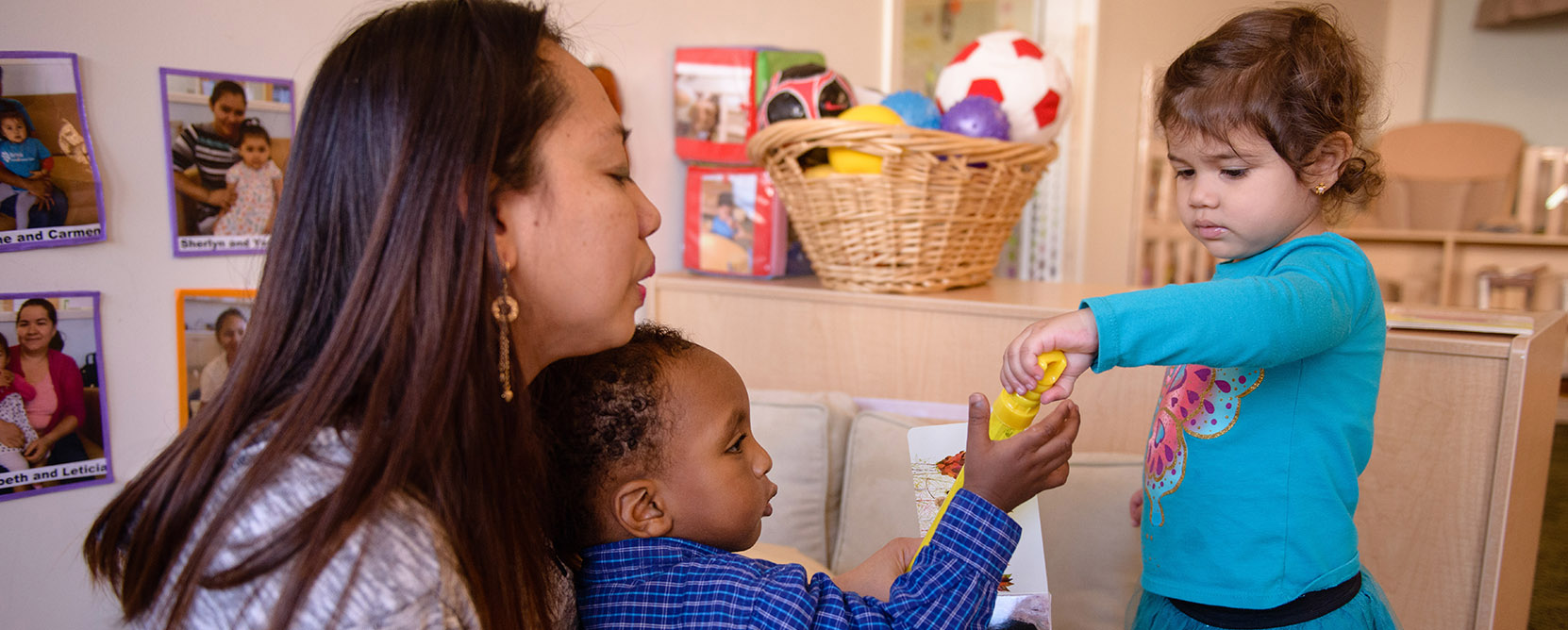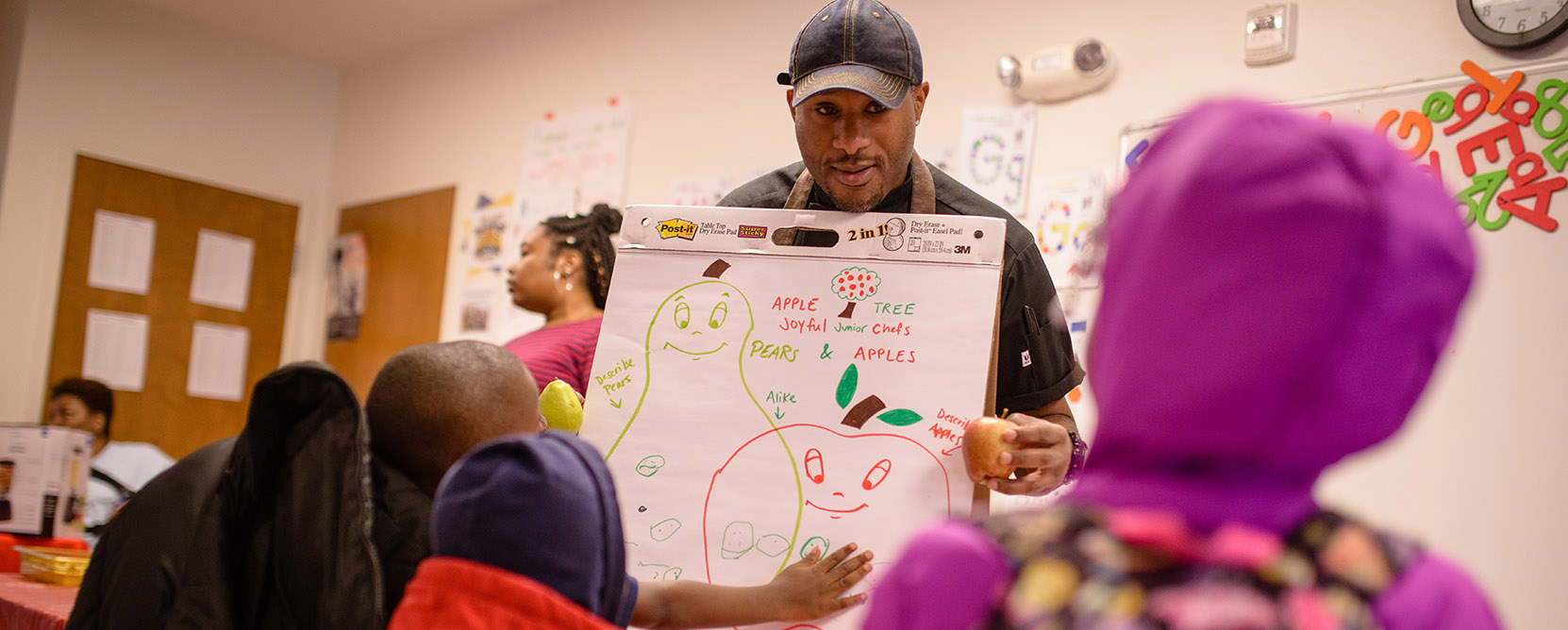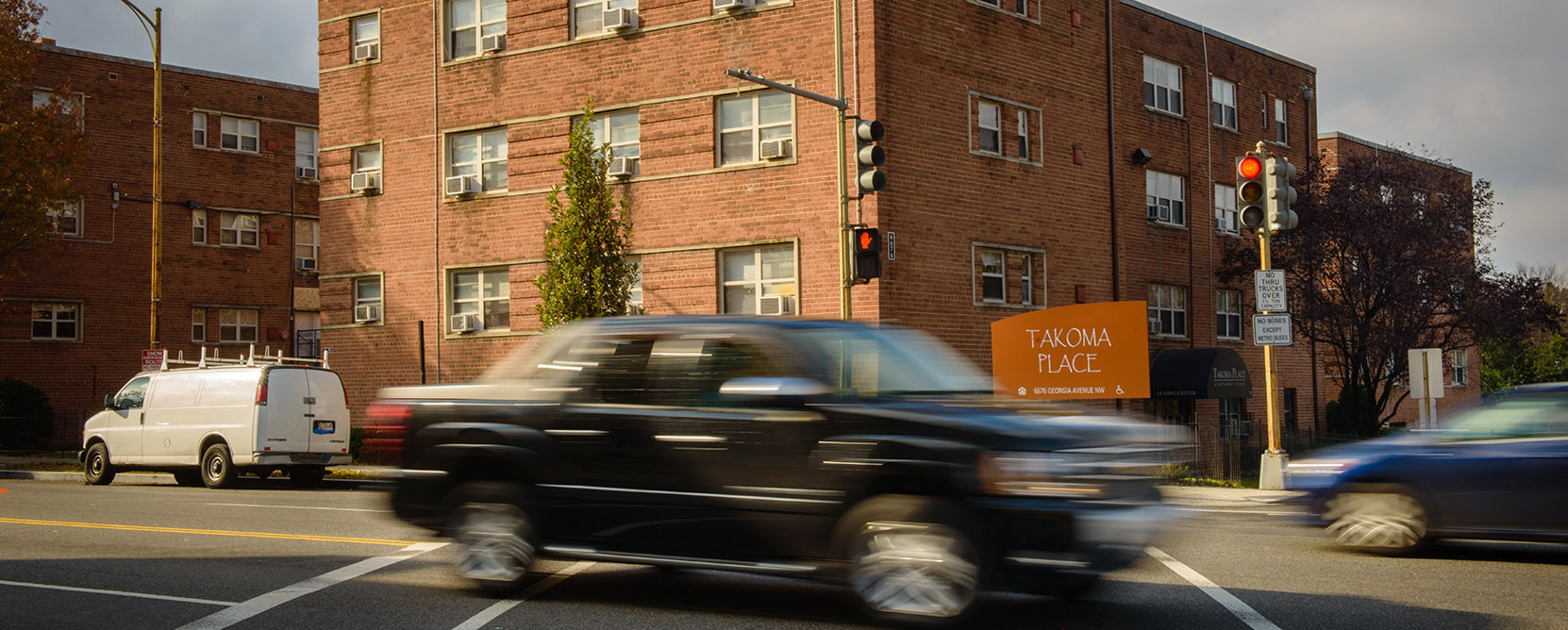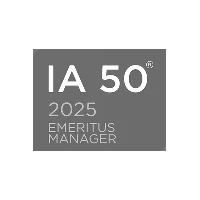
Diana Delgado, a mother of three, never dreamed she would soon be attending school and improving her life. What’s even more thrilling: Diana enrolled in an advanced two-level English adult education class at the same school her 2-year-old daughter, Gabriella, attends.
All that was made possible thanks to the Briya Public Charter School in Fort Totten, a low-income community located in D.C.’s Ward 5. Briya’s unique “two-generation” educational model is a game changer for families like the Delgados.
“My life has changed a lot since I started at Briya,” Diana says. “I really wanted to come because I want to be fluent in English. At the time, I was in my house, not working, and taking care of my kids. Daycare is so expensive, so I stayed home while my husband worked. But when I heard about the school, I thought, ‘I really need this.’ And when they told me that my daughter could be in a classroom with a teacher learning also…it just seemed so wonderful.”
“When I heard about the school, I thought. ‘I really need this,'” says Diana Delgado, seen here with her daughter. “And when they told me that my daughter could be in a classroom with a teacher learning also…it just seemed so wonderful.”
Briya embraces all members of its community, no matter their socioeconomic background, giving students and their families the tools to be successful. In addition to learning English, Diana is learning other skills, including how to use technology. Briya also provides information about health, nutrition, and obtaining legal advice.
“Other states and countries do not have a program like this. It’s one of a kind,” Diana says. “It will help you to be successful and will prepare you to have the tools to help your children also.”
Not only does Diana have a better command of the English language, she is also comfortable enough to get more involved in her older children’s school, even serving as vice president of the parent-teacher union.
“Briya’s unique two-generation model also addresses key needs in educational attainment for children,” says Lauren Stoltzfus, Briya’s communications coordinator. “Studies show that reading to young children helps language acquisition and correlates strongly with literacy development and future school success. Parents who are less educated are much less likely to read to their children.”
Briya’s unique “two-generational” model allows Diana Delgado to take English and technology classes while her daughter attends pre-school at the same facility.
Other studies have shown that 39 percent of mothers without a high school diploma read to their 3- and 4-year-old children daily, whereas 71 percent of mothers with a high school diploma do. Sixty-five percent of parents of Briya students have not graduated from high school, and those entering Briya’s lowest-level English class have the equivalent of a sixth-grade education.
Adult education is not the only innovation Briya has brought to the community. Briya also leases space to Mary’s Center, an on-site Federally Qualified Health Center that provides medical, dental, behavioral health, education, and social services to students and nearby residents. In addition, Mary’s Center helps provide access to the Special Supplemental Nutrition Program for Women, Infants, and Children (WIC). This program helps families by dispensing nutrition education, issuing checks for healthy supplemental foods, and providing access to farmers markets.
Diana utilizes Mary’s Center’s health center for her three children, 29 months, 4, and 6, to visit their pediatrician, access dental services, and receive vaccinations. Additionally, she participates in the Zumba class that Mary’s Center offers on Wednesdays.
“Mary’s Center is important for me because the majority of their personnel are bilingual, which makes me feel comfortable when I want to express the information to my kids accurately,” Diana says. “The employees are friendly, professional, respectful, and caring with the patients. Since we arrived to this city 18 months ago, I can say with confidence that I trust them with the health of my children. The fact that they are connected to the school also makes it much more possible to schedule regular care.”
“Briya’s and Mary’s Center’s work is based on a comprehensive social change model with three major areas: education, health care and social services…We know that in order for people to succeed in school—and thrive in life—their non-academic needs must be addressed as well.”
Lauren Stoltzfus, Briya’s Communications Coordinator
“Briya’s and Mary’s Center’s work is based on a comprehensive social change model with three major areas: education, health care, and social services,” Stoltzfus says. “We know that in order for people to succeed in school — and thrive in life — their non-academic needs must be addressed as well. How can you learn well in the classroom if you don’t have food to eat, or if you’re often sick but don’t know how to access a reliable doctor, or if you are facing domestic violence in your home? We believe that we can help families achieve better long-term outcomes by working together rather than working separately.”
As a mission-driven lender, Capital Impact Partners is interested in supporting projects that provide multiple services in one location. For many low-income residents, the ability to access services is often limited due to work schedules and childcare constraints. When you can locate critical services together where residents already live or commute to, you dramatically expand the opportunity for them to proactively seek out the health care, education, healthy food, or other services they need to live healthier lives.
So when the owners of the property that houses Briya were looking for financing, Capital Impact worked with other lending partners to put together a financing package centered on $34 million in New Markets Tax Credits (NMTC). The NMTC program is part of the U.S. Treasury’s Community Development Financial Institutions (CDFI) Fund, which helps attract private capital to low-income communities. In addition to hosting Briya and Mary’s Center, the mixed-used development is home to Bridges, a kindergarten through fifth-grade public charter school.
In addition to the education opportunities Briya provides to Diana Delgado and her daughter, the on-site health Center, Mary’s Center, also makes it easy to seek regular medical care for the entire family.
The services Briya and Mary’s Center provide are vital to the community. The area surrounding Briya is federally designated as a medically underserved area. Without Mary’s Center, residents would have extremely limited health care access.
And, according to the state education agency’s State of Adult Literacy Survey, more than 170,000 people in D.C. function at the Survey’s lowest literacy level. This number is 36 percent of the city’s population. In addition, Hispanic adults in D.C. comprise 13 percent of the population, yet 39 percent of the demographic has limited literacy skills. Seventy-six percent of Briya’s students identify as Hispanic/Latino.
These statistics reinforce the importance of equitable access to these services for the 100 infant to preschool children and the 209 adult students who attend Briya, as nearly 100 percent qualify for free and reduced meals (versus the city average of 79.5 percent).
“Briya was looking to expand for several years in response to a high need for our services. After studying our student data and listening to our students, we found that a majority of them live in wards 4 and 5, and that the immigrant population in these parts of the city was increasing,” Stoltzfus says. “We therefore strategically searched for a building located in this area where our students and potential students reside, as well as a location near public transit hubs and one that had outdoor space for our early childhood students to play.”
The new development also brought employment opportunities to the area, including entry-level positions that can be filled by residents of the neighborhood and provide opportunities for them to gain additional skills and grow professionally.
Building Healthy Communities in our Backyard

In 2017, Capital Impact provided nearly $40 million in loans to support projects creating social impact across the city. Click this link to view the full map of these projects.
In addition to supporting projects that co-locate important social services, Capital Impact’s interest in the Briya/Mary’s Center project is a desire to increase its role in supporting more projects across Washington, D.C.— in the “backyard” of its headquarters.
“Over the past two to three years, Capital Impact has put forth a strategy to increase its commitment to D.C. communities,” says Abi Suarez, Capital Impact’s East Coast business development officer. “As a mission-driven lender, we are focused on supporting projects that can help increase equitable access and inclusive growth opportunities for low-income residents. We are particularly excited about projects than can provide multiple services in one location.”
Another example of this effort is the organization’s support for the relocation and expansion of Martha’s Table’s headquarters, which is being built as part of a new 3-acre community-services campus development project in one of Washington, D.C.’s lowest-income areas. Martha’s Table is a 37-year-old organization that addresses poverty by increasing access to quality education programs, healthy food, clothing, and family supports through a variety of innovative methods.
“A lot of the opportunity that a child needs is rooted in community-grounded access to education and quality food,” says Ryan Palmer, chief external relations officer for Martha’s Table. “Currently, our focus is on those early years and success by third grade. We also dig deep on our healthy food programing.”
For nearly 40 years, Martha’s Table has provided Washington, D.C.’s underserved communities with equitable access to healthy food and other critical social services. Its new campus will allow staff to increase their offering to health care and housing – all centrally located at one facility.
The organization will anchor the new 55,000-sq.-ft. development known as “The Commons at Stanton Square,” which will also become home to a new branch of Community of Hope, an FQHC that will provide behavioral health services, connections to health services, and support for families and individuals. A third component will feature 125 affordable-rent one- to three-bedroom apartments and 42 market-rate three-bedroom townhomes.
Palmer notes that a campus that co-locates a variety of key social services would help address crucial disparities that have long plagued the surrounding communities. It will also help spur economic development that will benefit local residents.
Martha’s Table representative Ryan Palmer notes with excitement that the new campus which co-locates a variety of key social services will help address key disparities that have long plagued the surrounding communities as well as help spur economic development that will benefit local residents.
Services Martha’s Table will offer at its new headquarters include preschool programs, food distribution, nutrition, and parenting workshops, as well as a new food market. Considering that there are only three grocery stores serving 150,000 people in the surrounding communities, the need is abundantly clear.
The new headquarters will also support the Joyful Food Markets program it launched with the Capital Area Food Bank. The Joyful Food Markets are run exclusively inside elementary schools in the surrounding communities and provide no-cost access to fresh, healthy produce and pantry staples. In addition, the markets feature kids’ cooking activities, recipe samples, and chef-led culinary demonstrations designed to get children excited about healthy eating and cooking.
Martha’s Table staff like Chef JoJo seen here — go out into the local communities to set up “Joyful Food Markets.” These pop-up markets make it easier to distribute healthy food at facilities families already visit (such as schools or health clinics). They also help excite children to cook and eat healthy.
“Because of the markets, my 7-year-old son has become so excited about cooking and eating healthy,” shares Kimberly, a parent and volunteer at the Joyful Food Market at Savoy Elementary School. “He loves the cooking demonstrations with Chef JoJo and filling up his shopping bag with items he picked out. Then, as soon as we get home, he can’t wait to pull out the ingredients and help me in the kitchen.”
Capital Impact contributed $5.9 million in New Markets Tax Credits toward the $29 million transaction. Other investors included Local Initiatives Support Corporation (LISC) and City First with Morgan Stanley serving as the tax credit investor.
Supporting Revitalization and Affordable Housing
As part of its multifaceted project support across Washington, D.C., the Capital Impact team also has the opportunity to help longtime and low-income residents remain in their homes as the surrounding areas continue to gentrify and become more expensive.
Case in point: the Takoma Place apartments in the Brightwood neighborhood. Originally constructed in 1953, this 1.6-acre complex has long been home for working families. That all became at risk when the owner put the building up for sale.
The need to preserve these homes became even more urgent when “The Parks at Walter Reed” development was announced directly across the street. There was a real concern that this new 66-acre mixed-use campus would negatively impact current residents by driving up surrounding home and rent prices. The local population has a poverty rate of 20 percent, an unemployment rate of 18 percent, and a homeownership rate just above 50 percent, so the risk of displacing these residents was high without intervention.
Originally constructed in 1953, this 1.6-acre complex has long been home for working families. That all became at risk when the owner put the building up for sale.
“The need is for a full redevelopment that will preserve the affordability and make sure the property is stabilized for the long term,” says Mansur Abdul-Malik, assistant vice president, development for NHP Foundation, an organization responsible for expanding multi-family affordable housing endeavors. “This ensures that the property will remain affordable despite the neighborhood becoming more expensive. It will also improve it physically to make sure residents have a safe, decent, and modern place to call home.”
With the leadership role that NHP Foundation would play in supporting residents, combined with access to new services related to the Walter Reed development, Capital Impact saw this as a pivotal project with which to get involved. It joined with several partner organizations to put together a comprehensive $16 million financing package that enabled NHP Foundation to help nearby long-term, low-income Washington, D.C., residents stay in their homes.
The redevelopment will transform the property, creating a fresh new look that will dovetail well with all of the new development occurring in the area. The project also preserves 104 affordable housing units in a quickly gentrifying area of northwest D.C. — all reserved for families earning 60 percent of area median income and less.
“Since the residents of our property have diverse needs, we survey all of the residents of a particular property in order to find out which programs the residents would prefer…From this information, we then coordinate services [and] support on-site programs that meet these needs.”
Mansur Abdul-Malik, assistant vice president, development, NHP Foundation
“Since the residents of our property have diverse needs, we survey all of the residents of a particular property in order to find out which programs the residents would prefer,” Abdul-Malik says. “From this information, we then coordinate services, support on-site programs that meet these needs, and track the results in order to make necessary changes to improve the quality of the program. Preliminarily, residents of Takoma Place have asked about our financial empowerment and educational development programs. The final form of this will be decided after all residents have provided input on the programs they would like to see at the property.”
The programs that NHP Foundation provides are designed to enrich the lives of residents and help mitigate many of the obstacles that affect people of all income brackets, especially those with lower incomes.
“Therefore, the programs provide the support, venue, and training for a resident to make life changes that may afford them the ability to move out of rent-restricted housing into market-rate housing or homeownership, thereby creating an opportunity for another family in need,” Abdul-Malik says.
In addition to the leadership role that NHP Foundation plays in supporting residents and keeping units affordable, the Takoma Place apartments provide valuable access to transit and a variety of new services related to the nearby Walter Reed development.
Maintaining housing affordability was also vital for the longtime residents of the Mass Place Apartments located just a few miles south of the Takoma Place project in the heart of Washington, D.C. Beginning in the 1990s, as the area became more affluent, the number of African American residents dropped from 60 percent to just 20 percent. The current racial disparity is especially stark: The median income for black households in the census tract is $15,751, while white households have a median income of $98,722.
Given that the property is highly accessible by public transportation — located blocks from all five metro lines as well as other key services — helping lower-income residents stay in their homes was paramount.
Capital Impact joined with partner CDFI, LISC, to provide $7.5 million in financing and enable the National Housing Trust (NHT), an affordable housing preservation advocacy organization, to purchase the property. NHT will work with the tenants’ association representing residents of the 160-unit building to rehabilitate the Mass Place property and maintain affordability.
“By strategically financing developers that share our mission and values, we can help build healthy communities that include affordable housing with access to a variety of quality services such as education, healthy foods, and health care,” says Abigail Suarez, Capital Impact’s East Coast business development officer. “We can increase access, we can reduce inequality and create opportunities for residents to break the barriers to success.”
LEARN MORE ABOUT OUR WORK
